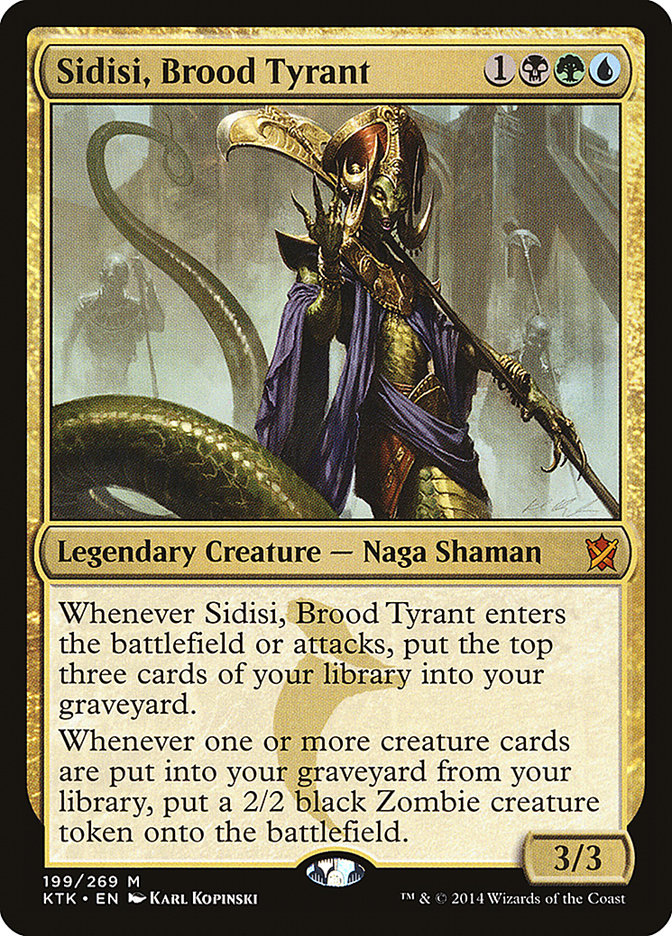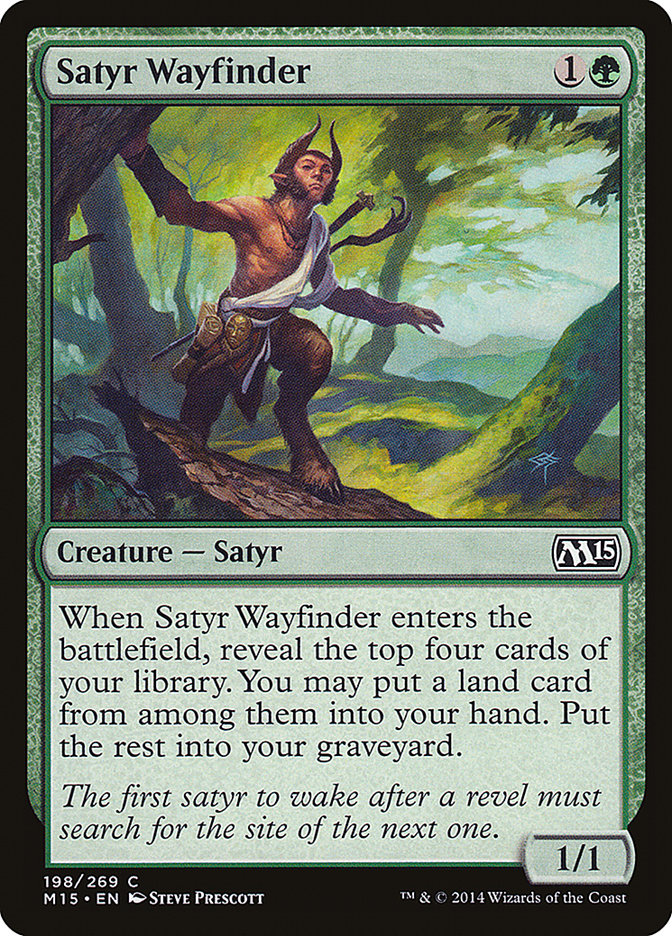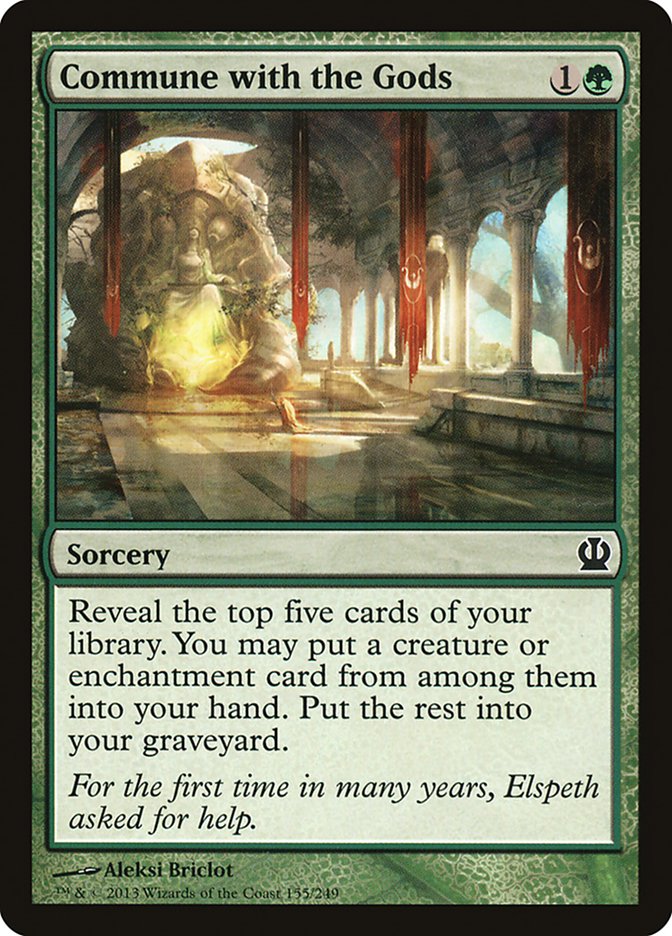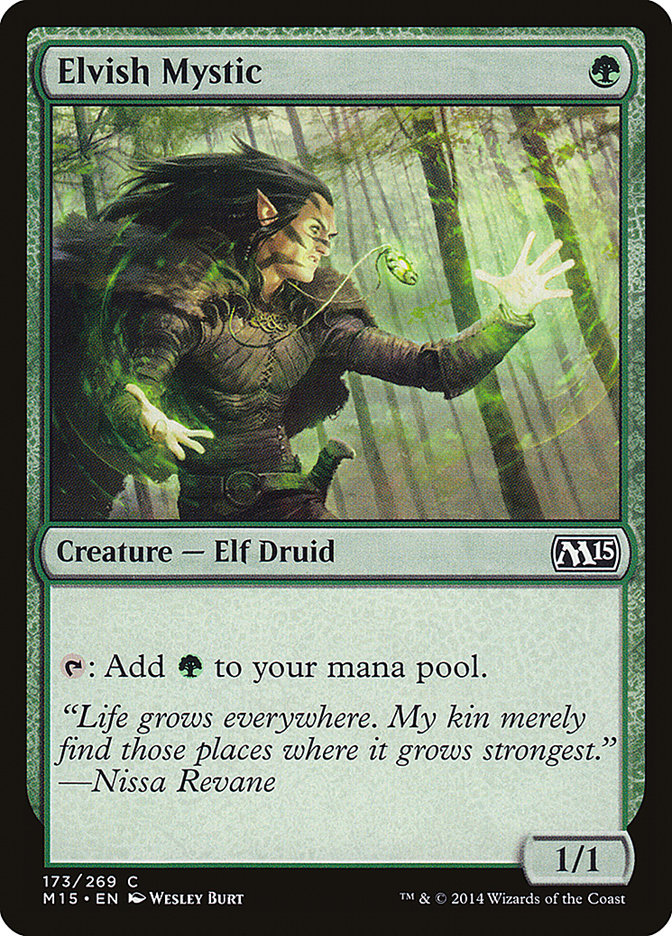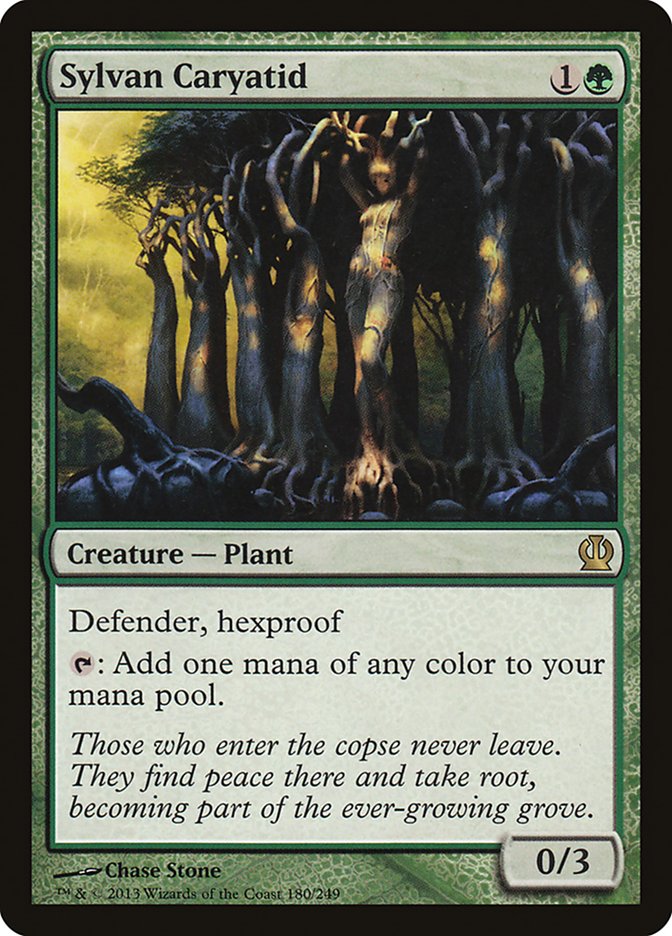“Everyone else should just be embarrassed.”
Those were the words that came out of my mouth when Tom “The Boss” Ross won his second StarCityGames.com Invitational…in a row. I just felt inadequate,
knowing that it was very unlikely that I would ever reach a point in my game where I could replicate that kind of success. I’ve seen him play. I’ve watched
him build decks. I’ve talked to him about sideboard choices, and I just can’t fathom what’s going on behind those eyes.
Speak softly and carry a big stick.
But if you can imagine, the weekend didn’t quite go as well for me. I came oh-so-close to making Top 8 of the Legacy Open on Sunday with Deathblade but
fell short after a few bad draws to Ross Merriam and his “Elfs.” The deck can be incredibly explosive and hard for any deck to deal with, let alone a
grindy fair deck, but I can pinpoint that loss on an unfamiliarity on how to sideboard. In the last year, Deathblade has undergone serious changes, and my
thoughts on what to board out were just incorrect, and I suffered greatly for it.
But enough about the past. There isn’t anything we can do to change it (unlike Sarkhan), but instead must look inward and grow from the mistakes we’ve
made. On the horizon is a new set, Khans of Tarkir, and it is shaping up to be one of the coolest sets in recent memory. I greatly enjoyed Shards of Alara
Block, both in Limited and Constructed (though I could have done without cascade), and Khans of Tarkir has a similar feel to it.
The factions on Khans of Tarkir will be formed in the “enemy wedges,” ala the enemy colors associated with each color. Blue will be paired with Red and
Green, Black will be paired with White and Green, and so forth. It will be interesting to see these wedges when stacked alongside the devotion mechanic
from Theros block, which pushed more towards mono-colored decks. But the part I’m most excited about is the rotation of Return to Ravnica and M14.
Mutavault has long since been a problem card, pushing things like Pack Rat over the top, while the multi-colored spells from Ravnica have overpowered just
about everything else.
I’m sure there will be some big, swingy spells from Khans of Tarkir that will fill the gap that Return to Ravnica will leave behind, as both were
“multi-colored” sets, but I doubt they will make the mistake of Sphinx’s Revelation again anytime soon. Hopefully control decks will have to fight a bit
harder for their end-game spells.
Sultai
While the spoiler is quite limited, I did want to talk about some of the new cards and how well they could potentially interact with the tools we already
have at our disposal. First up is one of my favorites:
While this card is a bit difficult to cast, I think that’ll be par for the course once we see the entire spoiler. The one aspect about Sidisi that I love
is that you don’t actually have to build your deck around her, other than playing a reasonable number of creatures to mill over. She acts much like a Titan
in that her ability triggers upon entering the battlefield, as well as attacking and will simply win the game if left unchecked. You must note that her
ability can never create more than one Zombie at a time, regardless of how many creatures you mill over.
Sidisi also acts as an enabler. Cards like Nemesis of Mortals and Whip of Erebos go nicely with Sidisi, fitting together like pieces of a puzzle. You can
“go medium” with Whip, using it to bring back Sidisi and hopefully getting a Zombie out of each trigger, or you can use Sidisi to mill over fatties like
Ashen Rider for maximum value. During testing for Pro Tour Journey into Nyx, we tried out a lot of three and four color decks that were trying to do
exactly this, but now we have better mana and hopefully more enablers.
With these two enablers already booked, I’d be surprised to see one better. Grisly Salvage was quite powerful in Standard at multiple points, and I don’t
see them giving us much more than these two to work with. Otherwise, Sidisi might just be nuts.
The deck is customizable, but here is where I would start.
Creatures (26)
- 4 Elvish Mystic
- 1 Abhorrent Overlord
- 4 Sylvan Caryatid
- 4 Nemesis of Mortals
- 4 Courser of Kruphix
- 4 Satyr Wayfinder
- 2 Necropolis Fiend
- 3 Sidisi, Brood Tyrant
Lands (19)
Spells (11)

The above is 56 cards, but I’d certainly play the four copies of the Sultai tri-land. Unfortunately, I can’t rightly build a sideboard just yet, with so
few cards spoiled. I don’t know exactly what I want to beat, what I’m weak to, or even what options I have other than what’s in Theros and M15. What I do
know is that the core of this deck is strong, giving you access to a significant amount of ramp and virtual card advantage.
I love Necropolis Fiend as a finisher, but he could easily be ousted by some Sultai baddie that we’ve yet to see. I think the delve mechanic will fit
nicely into this deck, and I think the fiend will be easy to cast as well as activate over and over until all of your opponent’s creatures are dead.
The removal in the deck is actually just a nod to how powerful Silence the Believers was in our Block testing. It doesn’t kill planeswalkers like Hero’s
Downfall, but it does just smash through other midrange decks. The ability to exile the gods, the enablers, and most finishers is huge, though an opposing
Xenagos, the Reveler or Elspeth, Sun’s Champion could prove too taxing to overcome. Ashen Rider used to be one of the easiest ways to beat Elsepth, as you
could invalidate the three tokens quite easily with Courser of Kruphix and Sylvan Caryatid, but I don’t exactly know how it could fit into the deck without
reworking the mana or focusing much more on the reanimation theme.
Bitter Revelation is another card that looks pretty interesting, though not exactly powerful. It does allow you to put the cards “from your deck into your
graveyard,” which works nicely with Sidisi, but I’m mostly using it as Foresee, digging for specific threats or answers in the mid or late game. The deck
might end up wanting more, but one seems like a reasonable number to begin with.
The manabase is a little bit awkward, as Polluted Delta doesn’t exactly do what you want it to do. It is possible that Llanowar Wastes or Yavimaya Coast
deserve slots, but I think that the Temples from Theros will shine if this format is as slow as I expect it to be. Having your lands coming into play
tapped shouldn’t be that big of a deal, but it will take more knowledge of the cards in Khans of Tarkir to get a better idea of how to build the manabase.
The Green Team
There will be a core for most green decks in the Standard format for the next year, and it starts like this.
These three cards will define midrange strategies, and what you do with access to all that mana is completely up to you. You don’t even need to be one of
the wedges to compete, as Theros and M15 give us a lot to work with, let alone some unspoiled goodies that are “enemy colored.” My personal favorite is
Naya Midrange, giving you access to Xenagos, the Reveler and Elspeth, Sun’s Champion. This tag team can put a lot of pressure on the opponent without
opening you up to a wrath effect against control, and continually building up a gigantic board presence against aggro and other midrange strategies.
I’m not sure if Sarkhan, the Dragonspeaker will make the cut, but mostly because I want to lean more heavily towards White as opposed to Red for the
support color. Even though Windswept Heath and Wooded Foothills make the manabase awesome, I’m not sure how many basic lands you want to play. Having
enough in your deck to continually search up is important for making Courser of Kruphix into an all-star, but you have to balance that with Temples and
potentially Battlefield Forge. I wouldn’t even be surprised if some number of Mana Confluence got thrown into the mix.
Without having seen much from the new set, here’s how I would build a Naya Planeswalkers shell.
Creatures (16)
Planeswalkers (10)
Lands (25)
Spells (9)

For starters, this deck is very straightforward. It isn’t trying to be tricky, has few instants, and you’re generally going to try and brute force your way
through any game. You want all of your threats to hit very hard, and potentially close a game on their own, all without losing to generic spot removal
(outside of Polukranos). Your team of planeswalkers will all leave behind a bit of pressure even if they meet their downfall, but having them active for
more than a turn or two will start a snowball effect that will end the game quickly.
This deck will play out much like the Jund Planeswalkers deck that currently exists in Standard, but the removal is a bit worse. You have answers to a
variety of permanents thanks to Banishing Light, but I suspect that your opponent’s Banishing Light will keep it from being all that reliable. I expect
Banishing Light to significantly increase in play following the release of Khans of Tarkir, if only to help deal with Sarkhan, the Dragonspeaker or the
plethora of gigantic, tri-color baddies that are sure to crop up.
I’m not sold on Polukranos being all that necessary, but it’s certainly the biggest body for the four-drop slot and can end the game quickly all by itself
if left unchecked. Its ability to keep smaller creatures at bay, both with his monstrous ability and his gigantic body, is a boon for a deck that is trying
to establish dominance on the board. The more you can slow the game down, the more activations you will get out of each planeswalker.
Unfortunately, this deck doesn’t get to show off much from Khans of Tarkir except for the fact that you get to play eight fetchlands that can find a
Forest, making the play of Elvish Mystic on the first turn pretty easy. That could be even higher if the format ends up slow enough for Mana Confluence,
which seems like a perfect fit for this style of deck. If you watched Pro Tour Journey into Nyx, there were a ton of midrange strategies that dominated the
field and most were using Mana Confluence to make sure they could cast their spells on time, which ultimately was a result of Courser of Kruphix and Sylvan
Caryatid being so dominant. Without much in the way of real pressure to affect your life total, Mana Confluence is absurd in three-color decks! If the same
holds true for Khans of Tarkir Standard, then Mana Confluence will be a very big game indeed.
It is possible that something like Genesis Hydra is very good in a deck like this. You don’t have the explosive power of Nykthos, Shrine to Nyx, but it is
a form of card and mana advantage if you hit something strong. In a lot of the Green Devotion decks, I found myself flush with extra mana even without
Nykthos, and I can attest to how solid a Genesis Hydra for X=4 or 5 can be. I know that six or seven mana is a lot to invest in a card that’s just a big
dumb body and a little bit of gamble, but it can swing games heavily in your favor.
It is possible that Rattleclaw Mystic might deserve a spot in this deck. Its ability to function like Lotus Cobra cannot be denied, though it isn’t quite
in the right color combination. You also don’t want to fill your deck with too much fluff, as it can be easy to flood out with excess lands and
mana-dorks.
My other concern is a lack of something swingy to do with Xenagos, the Reveler’s mana producing ability. Stormbreath Dragon was the generic go-to-threat
with Xenagos, but I think that time has passed. Stormbreath Dragon is great, but I want my threats to survive removal if at all possible, and I think
Nissa, Worldwaker fits the bill much more appropriately for this style of deck. After all, we are usually trying to attrition out our opponents.
B-A-N-A-N-A-S
With all this talk about tri-colored junk, all I can think about is Nykthos, Shrine to Nyx. With everyone so focused on fixing their colors with Temples
and tri-lands, I just want to explode and hit my opponent with giant monsters. Polukranos and Nissa were already discussed above, but I’m certain that
there will still be a shell for Green Devotion, even without Burning-Tree Emissary to fuel the fire.
As stated above, this is yet another Elvish Mystic, Sylvan Caryatid (kind of), Courser of Kruphix deck, and we even have Xenagos and Nissa, but the ideals
behind Green Devotion are much different from the Naya Planeswalkers deck above. Instead of trying to attrition our opponent out of the game, we’re going
bananas.
Creatures (28)
- 2 Hornet Queen
- 4 Elvish Mystic
- 4 Polukranos, World Eater
- 1 Nylea, God of the Hunt
- 4 Voyaging Satyr
- 1 Xenagos, God of Revels
- 4 Courser of Kruphix
- 4 Genesis Hydra
- 4 Rattleclaw Mystic
Planeswalkers (8)
Lands (24)

In the current Standard format, this deck has two weak matchups that are both fairly popular: Mono-Blue Devotion and U/W Control. Both of those decks prey
on creature-based strategies that rely on mana dorks to do the dirty work. Well, I’m here to tell you that both of those archetypes are going to get
significantly worse with the rotation of Return to Ravnica and M14. No more Tidebinder Mages. No more Supreme Verdict. Just good, clean Magic where you get
to do basically whatever you want.
I’m in, and this deck seems right up my alley. *Sniffle* Ol’ Dungrove Elder would be proud. And don’t even get me started on Kalonian Twingrove…
Without a cheap Wrath of God variant in the format for traditional control decks, that might put a bit more pressure on Anger of the Gods to fill the gap,
which will be pretty good against us. However, we still have a decent land count and Courser of Kruphix as early ways to fight against it. You will have to
play around Anger of the Gods the same way you have to play around Supreme Verdict now, except it will be much less devastating.
I’m opting to give Rattleclaw Mystic a chance instead of playing Sylvan Caryatid in this shell, mostly because I don’t want sixteen mana dorks, but also
because I want to be able to attack. Rattleclaw Mystic also has the added benefit of being able to generate an extra mana, so long as you have the time to
morph it. You don’t need the blue mana as it stands right now, but I could see a second splash if we have some awesome Temur cards to fit into the deck.
All it takes is more copies of Mana Confluence and some Yavimaya Coasts!
It is possible that more copies of Mana Confluence would help the deck out significantly in the two-color version, as casting Xenagos on time is key in a
number of matchups, but I don’t want to overload on them just yet. Xenagos, both in planeswalker and god form, fit in this style of deck magnificently.
Genesis Hydra pairs quite well with both of them, allowing you to go gigantic from either end. Have you ever cast a Genesis Hydra for X=10+? I have, and
I’ve also found Xenagod waiting for me on the other end.
A DE-light.
As a side note, I know that many people will ask about Chord of Calling, and I have an answer for you right here:
Don’t bother.
Genesis Hydra is the nuts. Trust me on that.
Sunset on our Return to Ravnica
As many of you know, I’m happy to see Return to Ravnica go. It was fun while it lasted, but those overpowered multi-color cards have seen enough play and
given me enough headaches. While I’m sure Khans of Tarkir will have some solid replacements, I’m just hoping they aren’t as oppressive.
Three-color spells are much different than two color spells, being both harder to cast and generally costing more mana. I’m definitely excited to see what
Khans of Tarkir brings to the table, and the cards already spoiled are making me hungry for more.
I’m concerned that many decks people build in the beginning of the format will be too slow, and they’ll forget about a lot of the strategies that Theros
has to offer. I fully expect aggressive decks to take advantage of painful, slow manabases. Goblin Rabblemaster will be heavily played, and people will get
punished for trying to be too cute. Stoke the Flames is still a card, after all.
We are losing quite a bit from Return to Ravnica, but I can only assume that’s a good thing. Standard has been boring for months, simply because there were
too many powerful cards that invalidated new archetypes, so rotating half of them and giving new life to existing strategies should be awesome. To me, this
is always the best time of the year for Magic!
I don’t know what Khans of Tarkir is going to do to the Standard format just yet, but I honestly can’t wait to see.

